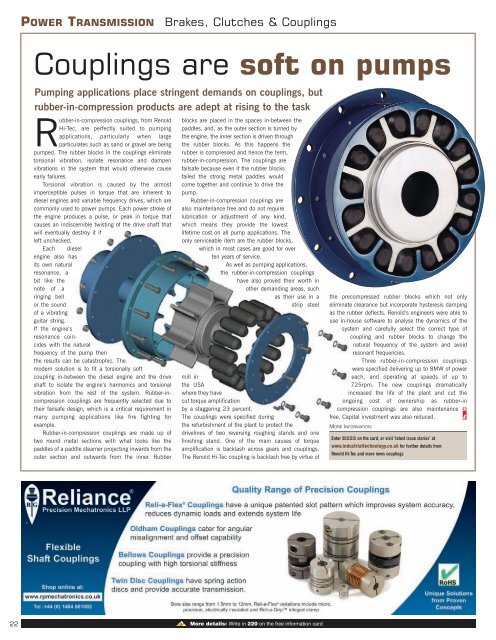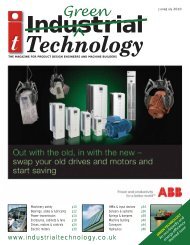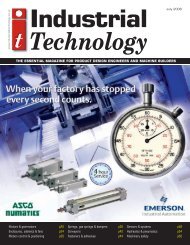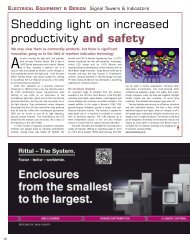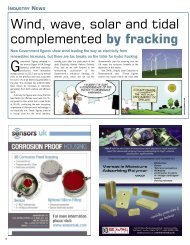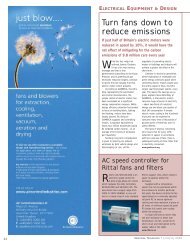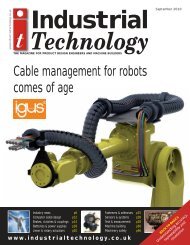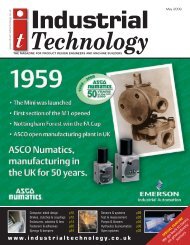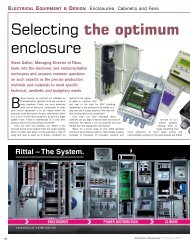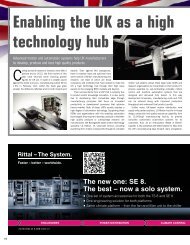sensors & systems - Industrial Technology Magazine
sensors & systems - Industrial Technology Magazine
sensors & systems - Industrial Technology Magazine
You also want an ePaper? Increase the reach of your titles
YUMPU automatically turns print PDFs into web optimized ePapers that Google loves.
POWER TRANSMISSION<br />
Brakes, Clutches & Couplings<br />
Couplings are soft on pumps<br />
Pumping applications place stringent demands on couplings, but<br />
rubber-in-compression products are adept at rising to the task<br />
Rubber-in-compression couplings, from Renold<br />
Hi-Tec, are perfectly suited to pumping<br />
applications, particularly when large<br />
particulates such as sand or gravel are being<br />
pumped. The rubber blocks in the couplings eliminate<br />
torsional vibration, isolate resonance and dampen<br />
vibrations in the system that would otherwise cause<br />
early failures.<br />
Torsional vibration is caused by the almost<br />
imperceptible pulses in torque that are inherent to<br />
diesel engines and variable frequency drives, which are<br />
commonly used to power pumps. Each power stroke of<br />
the engine produces a pulse, or peak in torque that<br />
causes an indiscernible twisting of the drive shaft that<br />
will eventually destroy it if<br />
left unchecked.<br />
Each diesel<br />
engine also has<br />
its own natural<br />
resonance, a<br />
bit like the<br />
note of a<br />
ringing bell<br />
or the sound<br />
of a vibrating<br />
guitar string.<br />
If the engine’s<br />
resonance coincides<br />
with the natural<br />
frequency of the pump then<br />
the results can be catastrophic. The<br />
modern solution is to fit a torsionally soft<br />
coupling in-between the diesel engine and the drive<br />
shaft to isolate the engine’s harmonics and torsional<br />
vibration from the rest of the system. Rubber-incompression<br />
couplings are frequently selected due to<br />
their failsafe design, which is a critical requirement in<br />
many pumping applications like fire fighting for<br />
example.<br />
Rubber-in-compression couplings are made up of<br />
two round metal sections with what looks like the<br />
paddles of a paddle steamer projecting inwards from the<br />
outer section and outwards from the inner. Rubber<br />
blocks are placed in the spaces in-between the<br />
paddles, and, as the outer section is turned by<br />
the engine, the inner section is driven through<br />
the rubber blocks. As this happens the<br />
rubber is compressed and hence the term,<br />
rubber-in-compression. The couplings are<br />
failsafe because even if the rubber blocks<br />
failed the strong metal paddles would<br />
come together and continue to drive the<br />
pump.<br />
Rubber-in-compression couplings are<br />
also maintenance free and do not require<br />
lubrication or adjustment of any kind,<br />
which means they provide the lowest<br />
lifetime cost on all pump applications. The<br />
only serviceable item are the rubber blocks,<br />
which in most cases are good for over<br />
ten years of service.<br />
As well as pumping applications,<br />
the rubber-in-compression couplings<br />
have also proved their worth in<br />
other demanding areas, such<br />
as their use in a<br />
strip steel<br />
mill in<br />
the USA<br />
where they have<br />
cut torque amplification<br />
by a staggering 23 percent.<br />
The couplings were specified during<br />
the refurbishment of the plant to protect the<br />
drivelines of two reversing roughing stands and one<br />
finishing stand. One of the main causes of torque<br />
amplification is backlash across gears and couplings.<br />
The Renold Hi-Tec coupling is backlash free by virtue of<br />
the precompressed rubber blocks which not only<br />
eliminate clearance but incorporate hysteresis damping<br />
as the rubber deflects. Renold’s engineers were able to<br />
use in-house software to analyse the dynamics of the<br />
system and carefully select the correct type of<br />
coupling and rubber blocks to change the<br />
natural frequency of the system and avoid<br />
resonant frequencies.<br />
Three rubber-in-compression couplings<br />
were specified delivering up to 8MW of power<br />
each, and operating at speeds of up to<br />
725rpm. The new couplings dramatically<br />
increased the life of the plant and cut the<br />
ongoing cost of ownership as rubber-in<br />
compression couplings are also maintenance<br />
free. Capital investment was also reduced.<br />
MORE INFORMATION:<br />
Enter D225 on the card, or visit ‘latest issue stories’ at<br />
www.industrialtechnology.co.uk for further details from<br />
Renold Hi-Tec and more news couplings<br />
22<br />
More details: Write in 220 on the free information card


